PRIDE and FETISH FLAG GALLERY
|
LEATHER PRIDE FLAG |
|
|
The Leather Pride Flag is a symbol for the leather community, which encompass those who are into leather, Levis, SM, BD, uniform, cowboys, rubber, and other fetishes. The flag was created by Tony DeBlase and first displayed on May 28, 1989, at the International Mr. Leather contest in Chicago, IL. |
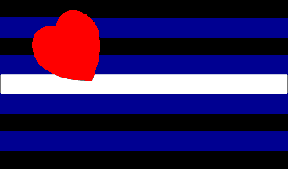 |
|
BDSM RIGHTS FLAG |
|
 |
Primarily seen in european counties, the BDSM Rights Flag The flag is inspired by the Leather Pride Flag and Quagmyr’s BDSM Emblem, but is specifically intended to represent the concept of BDSM Rights and to be without the other symbols’ restrictions against commercial use. It’s designed to be recognizable by people familiar with either the Leather Pride Flag or BDSM Triskelion (or Triskele) as “something to do with BDSM”; and to be distinctive whether reproduced in full color, or in black and white (or another pair of colors). For more information: http://www.bdsmrights.com/
|
|
BDSM EMBLEM |
|
|
The BDSM Emblem Flag shown here is a variation of the symbol created by Quagmyr in 1995. The Emblem is a symbol strictly for the SM, BD, and DS community only. For more information on the BDSM Emblem please visit Quagmyr’s site http://emblemproject.sagcs.net/ |
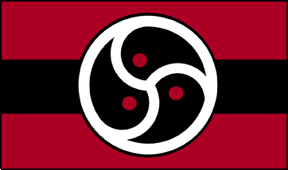 |
|
PUPPY PRIDE/DOG PRIDE FLAG |
|
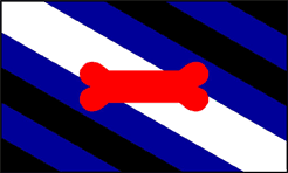 |
Created in 2011 by Pup Flip Gray (LeatherPup) for the The Puppy Pride Flag has the same number of stripes as For more information:http://www.leatherpups.com/z
|
|
THE SKINHEAD FLAG |
|
|
Created for the 10th Anniversary of FENIX Global Skin Movement (a gay-skinhead organization), the group felt there was a need to unite skins behind one flag, and this was the result. This flag was designed by SkinDavid and Shadowskin in Antwerp, Belgium in 2006. The feather crown represents the brotherhood ‘united’ aspect. For more information: http://www.fenix-gsm.net |
 |
|
MASTER/SLAVE and DOM/SUB FLAG |
|
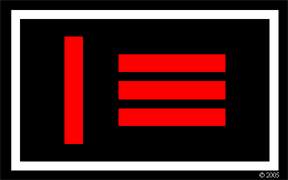 |
The “Master/slave and Dom/sub Flag” was unveiled at the Master/slave Conference in DC in July 2005 by Master Tallen and slave andrew. For more information, please visit their website: http://www.masterslaveflag.com/html/home.html Original design: Master Tallen 2005 |
|
SLAVE PRIDE FLAG |
|
|
The Slave Flag has been floating around on the web for sometime, sadly Its creator is unknown. The flag appears |
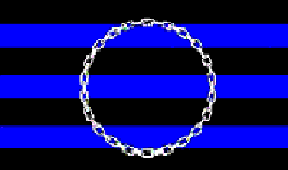 |
|
BOOTBLACK PRIDE FLAG |
|
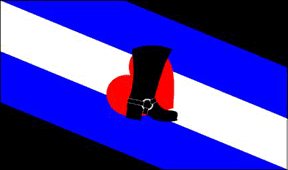 |
According to the Colors of Leather website, After a two year debate with in the community, on July 4th, 2005 Jesse ‘Spanky’ Penley came up with a design that would eventually become the accepted Boot Black Pride Flag. Which made its premier at the International LeatherSir/ International Leatherboy weekend in Atlanta, GA on Oct 6th, 2005.Using the Leather Pride colors, Spanky used a diagonal stripe to differentiate from the leather pride flag. The flag only uses three stripes, two blue, and one white. The width of the stripes, signify the wide range of people who are, and appreciate boot blacks. The unisex boot, stands for the non-gender specific nature of boot blacking. The large red heart positioned behind the boot, signifies the heart that the bootblack puts behind his or her boots. |
|
BOY/BOI PRIDE FLAG |
|
|
The Boy-Boi Pride Flag was created and designed by boy Keith and debuted at Mid-Atlantic Leather in 1999. The original flag now hangs in theLeather Archives and Museum in Chicago, IL. The flag appears here for the community and is not intended for any commercial use. |
 |
|
UNIFORM FETISH FLAG |
|
 |
The Military Fetish Flag has been floating around on the web for sometime; sadly Its creator is unknown. The flag appears here for the community and not for any commercial use. |
|
INTERNATIONAL RUBBER PRIDE FLAG |
|
|
This International Rubber Flag was designed by Peter Tolos and Scott Moats in 1994 as a means to identifying like-minded men and reflects the sensory, sensual, and mental passion |
 |
|
COWBOY FETISH FLAG * |
|
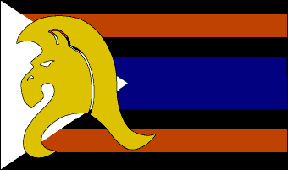 |
The (Leather) Cowboy Fetish Flag is a symbol for the leather and/or cowboy community, which encompass those who are into cowboys or who do live the life of the modern-day gay cowboy. The idea behind the creation of the symbol was to give the gay cowboy-cowboy fetish community a created symbol of there own. The artist does observe that the horse looks like a stylized Lambda symbol by chance, and not by design. The flag was created by artist Sean Campbell in 2001. |
|
BEHR PRIDE FLAG * |
|
|
The Behr Pride Flag is a symbol for the Bear community, which is composed by Gay men marked with (usually) an abundance of hair on their face, chest, and body. The flag elements are a bear’s paw and five colors representing the basic hair types. Created by Sean Campbell in 1995 and |
 |
|
INTERNATIONAL BEAR BROTHERHOOD FLAG |
|
 |
The International Bear Brotherhood Flag was designed to represent the Brotherhood of Bears. The International bear flag was designed by Craig Byrnes in 1995. (There is much debate about the origin of the bear flag, as well as Mr. Byrnes’ claim as the creator and copy right holder). The colors of the flag denote either hair colors or skin colors of the human race and was designed with inclusion in mind. |
|
GAY PRIDE FLAG (8 COLORS) |
|
|
The Gay Pride (Rainbow Flag) is a symbol for the gay community, which plays a part in many myths and stories related to gender and sexuality issues in Greek, Native American, African, and other cultures. The flag was created |
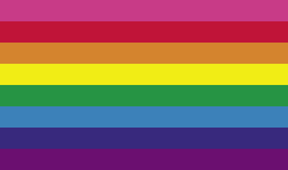 |
|
GAY PRIDE FLAG (6 COLORS) |
|
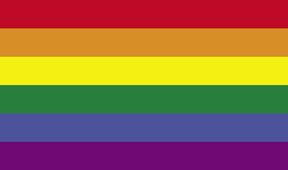 |
This is the more popular known Gay Pride (Rainbow) Flag, created in 1979 after the turquoise stripe was removed from the design and Indigo changed to royal blue. In 1989, the rainbow flag came to nationwide attention in |
|
GAY PRIDE FLAG with TRIANGLE FLAG * |
|
|
Many variations of the rainbow flag have been used. This version which includes a triangle, a well know symbol for gay rights was created by the artist Sean Campbell in 1999 and saw its first national use as an graphic element for a pride edition in GLT magazine in 2000. |
 |
|
GAY USA FLAG * |
|
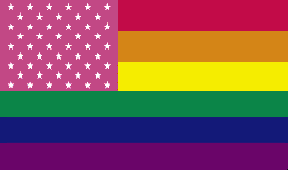 |
Many variations of the rainbow flag have been used. This version is United States of America flag with Gay Pride colors and a field of hot pink, it was created by the artist Sean Campbell in 1999 and first national use as an graphic element for a pride edition in GLT magazine in 2000. |
|
GAY PRIDE FLAG with BLACK STRIPE |
|
|
In the early years of the AIDS epidemic, AIDS activists designed a “Victory over AIDS” flag consisting of the standard six-stripe rainbow flag with a black stripe across the bottom. Leonard Matlovich, himself dying of AIDS-related illness, suggested that upon a cure for AIDS being discovered, the black stripes be removed from the flags and burned. |
 |
|
STRAIGHT ALLIES FOR EQUALITY FLAG |
|
 |
The Straight Allies flag emerged in the late 2000s for people who supported the LGBT Rights movement but did not personally use the rainbow flag because they did not identify themselves as being gay, or did not want to people to have the misconception that they were gay. The flag consists of a Rainbow upside-down ‘V’ on a black and white stripped background. The Rainbow ‘V’ represents the “A” in Activism, with the rainbow colours represented the Gay Pride flag. The black and white stripes represent heterosexuality. |
|
BI-SEXUAL PRIDE FLAG |
|
|
The bisexual pride flag was designed by Michael Page The deep pink or rose stripe at the top of the flag represents the possibility of same gender attraction; the royal blue stripe at the bottom of the flag represents the possibility of opposite gender attraction and the stripes overlap in the central fifth of the flag to form a deep shade of lavender or purple, which represents the possibility of attraction anywhere along the entire gender spectrum. |
 |
|
LESBIAN PRIDE * |
|
 |
The Lesbian/Labrys Pride Flag is a symbol for the lesbian community. The elements in this flag are the labrys, a double-sided hatchet or axe commonly used in ancient European, African, and Asian matriarchal societies as both a weapon |
|
LIPSTICK LESBIAN PRIDE FLAG |
|
|
The Lipstick Lesbian Pride Flag made its apprearance on the web on December 16, 2010. The author/creator is Nmdesigns (the name listed as the author on wikipedia website, but that may only mean that this person upload the file to wikipedia, and may not be the creator of the flag). Sadly that is all that is known and no other the information is available at this time. The flag appears here for the community and not for, nor used in any commercial use. |
 |
|
FEATHER/DRAG PRIDE FLAG * |
|
 |
The Feather Pride Flag is a symbol for the Drag community, which encompass those who are into Drag Queens, Fancy Kings, their courts and other fetishes. The phoenix which the gay community has embraces for its own as a symbol of rebirth, it is symbolic display here for the fires of passion which the drag community had in the early days of HIV/AID epidemic, raising funds for research within the gay community. The flag was created by artist Sean Campbell in 1999 and first national use as an graphic element for a pride edition in GLT magazine in 2000. |
* asterisk items are the creation of Sean Patrick Campbell, and have been copied righted under the artist name. These items are also declared public domain by the artist. The creator does not believe that graphics created to represent a community should be privately held or to be used for private economic commercial use when said icon(s) are to represent a community and not a self contain group or organization. The intention of copy righting the material is to prevent any other parties form claiming ownership of images, and there for preventing said images from being used , seen or otherwise by the community for which the design was attained for. The artists ask only if you do use the images, that credit be given to the creator, and that he is also informed about any commercial use, so he can look forward to seeing said product with his design. If you have any question on the icons, please feel free to contact the artist.
 The Greek letter lambda was selected as a symbol by the Gay Activists Alliance of New York in 1970. In December 1974, the lambda was officially declared the international symbol for gay and lesbian rights by the International Gay Rights Congress in Edinburgh, Scotland. The lambda signifies unity under oppression.
The Greek letter lambda was selected as a symbol by the Gay Activists Alliance of New York in 1970. In December 1974, the lambda was officially declared the international symbol for gay and lesbian rights by the International Gay Rights Congress in Edinburgh, Scotland. The lambda signifies unity under oppression.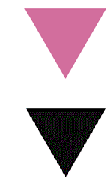 The pink triangle was used exclusively with male prisoners—lesbians were not included under Paragraph 175, a statute which made homosexual acts between males a crime. However, women were arrested and imprisoned for “antisocial behavior,” which included feminism, lesbianism, and prostitution, and was applied to women who did not conform to the ideal Nazi image of a woman. These women were labeled with a black triangle.
The pink triangle was used exclusively with male prisoners—lesbians were not included under Paragraph 175, a statute which made homosexual acts between males a crime. However, women were arrested and imprisoned for “antisocial behavior,” which included feminism, lesbianism, and prostitution, and was applied to women who did not conform to the ideal Nazi image of a woman. These women were labeled with a black triangle.












